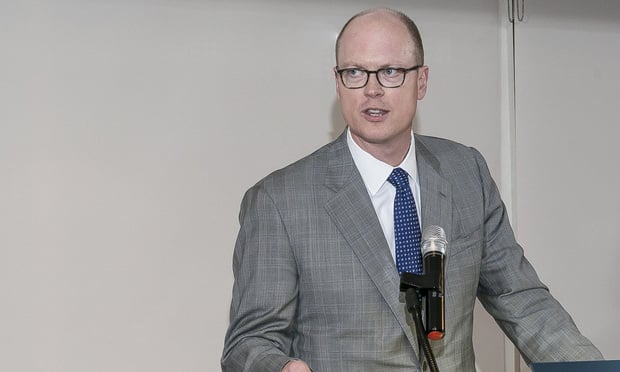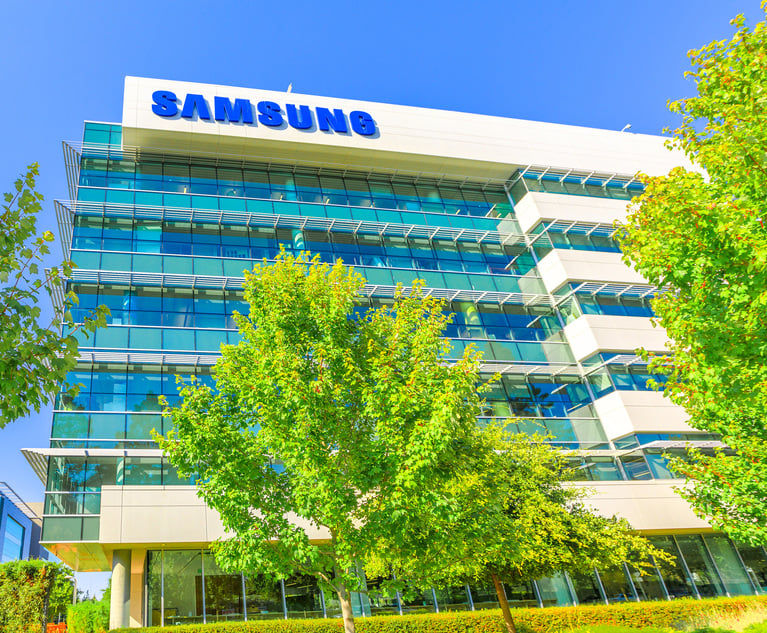Verizon GC Talks Approach to Yahoo Deal and How Breaches Impacted Strategy
Craig Silliman of Verizon spoke about the process of the negotiations with Yahoo and what it was like to navigate through the unique aspects of the deal.
February 23, 2018 at 06:52 PM
6 minute read
 Verizon general counsel Craig Silliman. Photo: Carmen Natale/ALM
Verizon general counsel Craig Silliman. Photo: Carmen Natale/ALM Last June, Verizon Communications Inc. announced that after more than a year, it had completed the acquisition of Yahoo Inc.'s operating business. Yahoo's revelations of two massive breaches soon after the ink had dried on the original agreement raised questions about whether the deal will go through, but with a price cut and a revision of language to allocate liability related to the security incidents, the sides were able to reach an agreement.
Or, as Verizon executive vice president of public policy and general counsel Craig Silliman described it in an interview Thursday, Yahoo and Verizon were ultimately able to find “an elegant way to move the deal to close.”
While Silliman was unable to discuss any litigation and government investigations related to the breaches, as these are ongoing matters, the Verizon GC spoke about the process of the negotiations and what it was like to navigate through the unique aspects of the deal.
Discussions with Yahoo began in the spring of 2016, Silliman said. By then, Yahoo's board had, for quite some time, been looking at what the best way forward for the company would be, which eventually included considering whether to put the operating part of the business on the market, U.S. Securities and Exchange Commission filings show.
Once the decision was made to sell, a “very structured process” was initiated and Verizon began doing due diligence in early 2016, according to Silliman. SEC filings show that “after a months-long bidding process” involving “multiple bidders,” Verizon came out as the winner and a deal was entered into on July 23, 2016, with the telecommunications giant slated to pay roughly $4.83 billion.
Quite a large team was involved in the due diligence and deal negotiation, Silliman said, to focus on everything from real estate holdings and tax questions to potential privacy issues. Silliman, along with the likes of the company's CEO and CFO, was part of the group that would consider the larger strategic questions around the deal. The foremost question was whether Yahoo's operating business was an asset that ultimately made sense for Verizon.
Then came the Sept. 22, 2016, announcement from Yahoo about a 2014 breach that impacted at least 500 million customer email accounts. Verizon had already started on integration planning at this point, Silliman said, but once the company was informed of the data breach on Sept. 20, the conversation turned to if the deal should still happen.
The question was whether there is “something about what … we've just discovered had happened that fundamentally affects the strategic rationale for why you wanted to buy the asset in the first place,” Silliman said. He added: “The reason we were buying the asset was the user base, the Yahoo user base. And so the question we had to ask ourselves is: Will this affect the Yahoo user base, their engagement with the Yahoo products and services?”
On Verizon's end, it was also critical to protect the company, Silliman said, because it wasn't clear at the time what the reaction would be to the news of the breach. “We put together a strategy almost immediately after the first breach was announced where we laid out how we wanted to move forward with getting more information from the Yahoo team in order to determine whether there had been an impact on the business, how great that impact would be,” he explained, noting those discussions continued into November of 2016.
Then, in December 2016, another breach was revealed, this one from 2013. This breach is now known to have likely impacted all of Yahoo's users at the time of the incident, or roughly 3 billion user accounts. “When they notified us of that,” Silliman said, “we essentially said, we now need to take a pause on renegotiating the deal because we have a new factor that needs to be evaluated to determine what the impact of the second breach is.”
As with all deals, closing with Yahoo came down to ensuring it was a smart move for Verizon, Silliman said. But what he said was so unusual about this particular deal was that there was a very public new development after the deal was signed, but before it was closed. “That happens sometimes, but rarely do you have an event that is so highly public, or in this case, two events that were very highly public,” the GC said.
To get to the point of closing the deal, which involved cutting the price by $350 million and amending the division of liabilities, Silliman explained it took plenty of negotiation and “a lot of very constructive and engaged conversations” with the other side.
Under the original deal terms, liabilities that might arise because of customer and partner lawsuits or government investigations would travel with the operating unit over to Verizon when the deal closed, according to Silliman. But when it came to the breaches, there was no way to know what the ultimate outcome of those proceedings might be, and thus, no certainty about the level of liability.
“The way we looked at it was, the only way to have certainty about what those numbers would be, would be to wait a very, very long time,” he explained. “But, if you wait a long time, you introduce uncertainty into your customer base, into your employee base.” The balance for Verizon then, he said, was to move quickly on close to get to certainty while also acknowledging that liability was still a question.
So the decision was made to split the costs associated with those liabilities. By doing this, he added, it “aligned the parties' incentives from the very beginning” because both then had the motivation to work closely together to get the best possible outcome when it came to any future proceedings.
“We thought it was an elegant way to move the deal to close, relatively close to our original timeframe, while also getting an equitable outcome for both sides,” Silliman said.
Stay on top of in-house developments with Inside Track, a weekly email briefing that breaks down the news, flags key issues, answers your questions, and keeps track of who's on the move. Sign up here and get the next briefing straight to your in-box.
This content has been archived. It is available through our partners, LexisNexis® and Bloomberg Law.
To view this content, please continue to their sites.
Not a Lexis Subscriber?
Subscribe Now
Not a Bloomberg Law Subscriber?
Subscribe Now
NOT FOR REPRINT
© 2025 ALM Global, LLC, All Rights Reserved. Request academic re-use from www.copyright.com. All other uses, submit a request to [email protected]. For more information visit Asset & Logo Licensing.
You Might Like
View All

Marriott's $52M Data Breach Settlement Points to Emerging Trend

2024 Ransomware Payments Poised to Shatter Record, as Gangs Target 'Big Game'
2 minute read
Cleared in HP Fraud Trial, British Tech Tycoon Mike Lynch Now Missing at Sea
Trending Stories
Who Got The Work
J. Brugh Lower of Gibbons has entered an appearance for industrial equipment supplier Devco Corporation in a pending trademark infringement lawsuit. The suit, accusing the defendant of selling knock-off Graco products, was filed Dec. 18 in New Jersey District Court by Rivkin Radler on behalf of Graco Inc. and Graco Minnesota. The case, assigned to U.S. District Judge Zahid N. Quraishi, is 3:24-cv-11294, Graco Inc. et al v. Devco Corporation.
Who Got The Work
Rebecca Maller-Stein and Kent A. Yalowitz of Arnold & Porter Kaye Scholer have entered their appearances for Hanaco Venture Capital and its executives, Lior Prosor and David Frankel, in a pending securities lawsuit. The action, filed on Dec. 24 in New York Southern District Court by Zell, Aron & Co. on behalf of Goldeneye Advisors, accuses the defendants of negligently and fraudulently managing the plaintiff's $1 million investment. The case, assigned to U.S. District Judge Vernon S. Broderick, is 1:24-cv-09918, Goldeneye Advisors, LLC v. Hanaco Venture Capital, Ltd. et al.
Who Got The Work
Attorneys from A&O Shearman has stepped in as defense counsel for Toronto-Dominion Bank and other defendants in a pending securities class action. The suit, filed Dec. 11 in New York Southern District Court by Bleichmar Fonti & Auld, accuses the defendants of concealing the bank's 'pervasive' deficiencies in regards to its compliance with the Bank Secrecy Act and the quality of its anti-money laundering controls. The case, assigned to U.S. District Judge Arun Subramanian, is 1:24-cv-09445, Gonzalez v. The Toronto-Dominion Bank et al.
Who Got The Work
Crown Castle International, a Pennsylvania company providing shared communications infrastructure, has turned to Luke D. Wolf of Gordon Rees Scully Mansukhani to fend off a pending breach-of-contract lawsuit. The court action, filed Nov. 25 in Michigan Eastern District Court by Hooper Hathaway PC on behalf of The Town Residences LLC, accuses Crown Castle of failing to transfer approximately $30,000 in utility payments from T-Mobile in breach of a roof-top lease and assignment agreement. The case, assigned to U.S. District Judge Susan K. Declercq, is 2:24-cv-13131, The Town Residences LLC v. T-Mobile US, Inc. et al.
Who Got The Work
Wilfred P. Coronato and Daniel M. Schwartz of McCarter & English have stepped in as defense counsel to Electrolux Home Products Inc. in a pending product liability lawsuit. The court action, filed Nov. 26 in New York Eastern District Court by Poulos Lopiccolo PC and Nagel Rice LLP on behalf of David Stern, alleges that the defendant's refrigerators’ drawers and shelving repeatedly break and fall apart within months after purchase. The case, assigned to U.S. District Judge Joan M. Azrack, is 2:24-cv-08204, Stern v. Electrolux Home Products, Inc.
Featured Firms
Law Offices of Gary Martin Hays & Associates, P.C.
(470) 294-1674
Law Offices of Mark E. Salomone
(857) 444-6468
Smith & Hassler
(713) 739-1250






